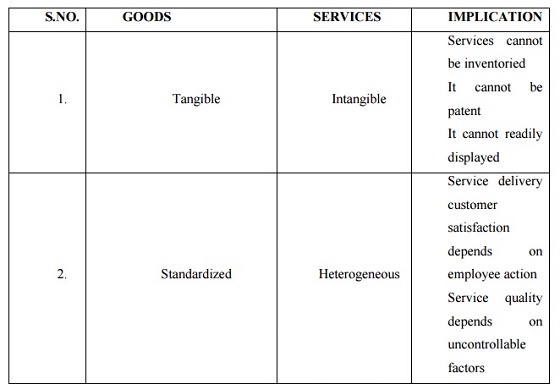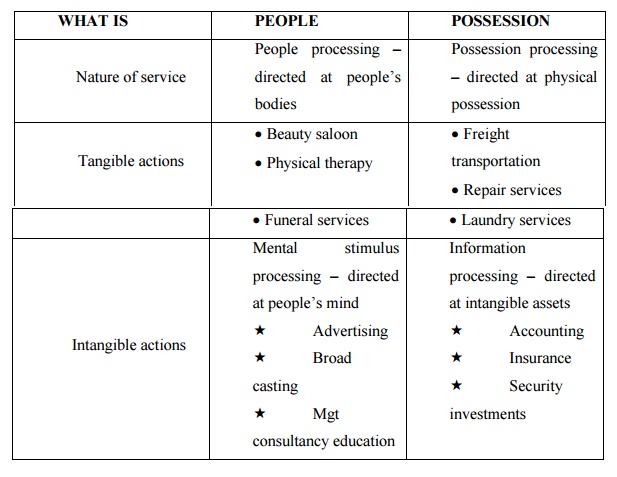Chapter: Business Science : Services Marketing : Introduction
Introduction to Service Marketing
INTRODUCTION TO SERVICE MARKETING
Definition
for service
Service is an act or performance offered by one party to another that essentially intangible and does not normally result in ownership of anything. Its product may or may not be tied the physical product.
Philip
Kotler
E.g.:
transportation, electricity.
DIFFERENCE BETWEEN GOODS AND SERVICES:


CHARACTERISTICS OF SERVICE
MARKETING:
1. INTANGIBLE:
Services are performance or actions rather than objects. They cannot be seen,
tasted or touched.
E.g.
Surgery, Examination
2. HETROGENITY:
Since
services are performances produced by human
Beings,
no two services will be alike. (it differs from hour to hour, day to day)
customers are not same E.g. Tax accountant may provide different service to two
customers
3. SIMULTANEOUS PRODUCTION AND
CONSUMPTION: Services are sold first and then
produced and consumed simultaneously
![]()

E.g. In a restaurant the services are sold first and
the dinner experience is produced and consumed at the same time
4. PERISHABILITY: Services referred to the
fact that it cannot be saved, Stored or returned
E.g.
A seat in an airplane
NATURE
OF SERVICE:
Diag:
Understanding the nature of service act
SCOPE
OF SERVICE MARKETING
A service business is one where the perceived value
of the offering to the buyer is determined more by the service rendered than
the product offered. In this way the nature and scope of services pose
different challenges for managers in service businesses. Such businesses
include those that provide an almost entirely intangible offering, such as
legal services, health care and cleaning services and businesses that offer
both services and products such as restaurants and retail outlets.
The definition and scope of the service concept is
wide and can mean any or all the following: Table 1.1: Scope of services

Service
activities Service as a concept
Customer
service A service organization
Service-based
activities As a core product
Added
value activities As an
augmented product
As
product support
As
an act
(a).
Service as an organization: It is the entire business or not-for-profit
structure that resides within the service sector. For example, a restaurant, an
insurance company a charity.
(b). Service as core product: The commercial
outputs of a service organization such as a bank account, an insurance policy or a holiday.
(c). Service as product augmentation: any
peripheral activity designed to enhance the delivery of a core product. For
example, provision of a courtesy car, complimentary coffee at the hairdresser.
(d). Service as product support: Any product
or customer-oriented activity that takes place after the point of delivery. For
example, monitoring activities, a repair service, up-dating facilities.
(e). Service as an act that is service as a
mode of behavior such as helping out and giving advice.
However
from a market or consumer point of view the relative importance of different
components of
the
service offering can range vastly from one customer to another. So a service
must be considered from the point of view of many types of customers. For
example, two people may pay the same amount for a service but may be paying for
different aspects of the service. A business person may dine regularly in an
expensive, upmarket restaurant because of the convenience to their place of
work and the perceived status of entertaining guests there. Other customers of
the same restaurant may eat there regularly because of the excellent food,
modern décor and menu choice.
SERVICE
ECONOMY
Meaning
of service economy:
The size of the service sector is
increasing in virtually all countries around the world. In emerging economies,
the service output is growing rapidly and often represents at least half of the
GDP. Thus, Service economy is growing. As a national economy develops, the
relative share of employment between agriculture, industry (including
manufacturing and mining).The service economy in developing countries like
India is mostly concentrated in financial services, health, and education.
FACTORS
CONTRIBUTING TO THE GROWTH OF SERVICE SECTOR
1.
GOVERNMENT POLICIES:
It is Govt. which makes mandatory for
price levels, distribution strategies, defining procedure attributes.
Another important action taken by the Govt.‟s
“Privatization” means the policy of transformcompanies.
The transformation of such operations
like telecoms, airlines has led to restructuring cost cutting and more market
focused.
PROS
OF PRIVATIZATION:
a. Increase
the efficiency
b. Increase
in profits
New change will require services firm to change
their marketing strategy, operational procedures, and HR policies.
2.
SOCIAL CHANGES
Now a day there is a drastic change, two members are
working, which requires to hire individuals to perform tasks that used to be
performed by a house hold member.
E.g.
Child
care
Laundry
Food
preparation
Combinations
of changing life styles like
√Higher
income
√Declining
prices for many high technology products –made for people to by computers.
√Mobile
phone etc.
Increased
imaginations into countries –U.S, Canada and Australia.
3.
BUSINESS TRENDS
Many professional associations have been forced by
Govt. to remove long-standing bars on adv and promotional activities.
Franchising
has become wider spread in many service industries.
Licensing
of independent entrepreneurs to produce and sell a branded service according to
tightly specified procedures.
4.
ADVANCES IN IT:
Changes
come from the integration of computers and tele-communication
More powerful software enables firm to create
databases that combine information about customers with details of all their
transaction, so that they can be used to predict new trends, segment the
market, new marketing opportunities.
The creation of wireless networks and
transfer of electronic equipments such as cell phones to lap tops and scanners,
to allow sales and customer service personnel to keep in touch.
5.
INTERNATIONALISATION AND GLOBALIZATION:
A strategy of international expansion
may be driven by a sector for new markets or by the need to respond to existing
customers who are traveling abroad in greater numbers.
When companies set up operations in
other countries they often prefer to deal with just a few international suppliers
rather than numerous local firms.
The net effect is to increase
competition and to encourage the transfer of innovation in both products and
processes from country to country.
CHALLENGES
AND ISSUES IN SERVICE MARKETING
(a). Tangibility
A product is tangible, which means the customer can
touch and see the product before deciding to make a purchase. Items such as
packaging and presentation may compel a customer to purchase a product.
Services, on the other hand, are not tangible, which can make them more
difficult to promote and sell than a product.
(b). Relationship and Value
Products
tend to fill a customer's need or want, so companies can use this to sell a
product. A service is more about selling a relationship and the value of the relationship
between the buyer and seller of the service. For example, a car is something a
buyer can touch and see as well as use. A service, such as lifestyle coaching,
for example, is not tangible. A lifestyle coach may be able to assist clients
in creating a life plan and implementing steps to transform his life into one
that the client wants to live, but it is not something tangible that the client
can place in his home and look at every day. Therefore, the client needs to
perceive the value of the service, which can be harder to get across.
(c). One Versus Many
Marketing
products tends to involve multiple products that make up the line. For example,
cleaning product manufacturers tend to market not just one cleaning product.
Instead, they have a line of cleaning products to serve the various needs of
their customers. Services, on the other hand, typically have a single option.
It can be harder to promote and sell the reputation of one single service over
the benefits of many different products.
(d). Comparing Quality
Measuring
the quality of a product is easier than measuring that of a service. If a
customer buys a cleaning product to clean the kitchen sink and it doesn‟t do
product is zero. On the other hand, it is harder to measure the quality of a
service.
(e). Return Factor
If
a customer purchases a product,thecustomerandcan returnit thedoes product for
her money back or at least to receive a store credit. A service is consumed as
it is offered, so it lacks the return factor that a product has. Some service
providers overcome this by offering money-back guarantees.
MARKETING CHALLENGES OF SERVICES:
Managing,
growing, and profiting with both product and service businesses are challenging
tasks. But the challenges are different from one to the other. Listed below are
some of the most common and difficult challenges of growing and .managing
consulting, professional, or technology service businesses that don‟t
necessary apply to
product business
(a).
Clients can‟t see or touch services before conceptualize and evaluate from the
client perspective, creating increased uncertainty and perception of risk. From
the firm‟s perspective, service in quality, and set price.
(b).
Services are often produced and consumed simultaneously: This creates special
challenges in service quality management that product companies do not even
consider. Products are tested before they go out the door. If a product has
quality problems while in production the company can fix them and customers are
none the wiser. Service production happens with the customer present, creating
a very different and challenging dynamic.
(c). Trust is necessary: Some level of trust
in the service organization and its people must be established before clients
will engage services. This is as important, sometimes more important, than the
service offerings and their value proposition.
(d). Competition is often not who you think:
Competition for product companies are other product companies. Competition for
service companies are often the clients themselves: Sure, sometimes you find
yourself in a competitive shootout (some firms more than others), but often the
client is asking „should we engage
this service;-house‟at.all‟ and
„i
(e). Brand extends beyond marketing: Brand
in service businesses is about who you are as much as what you say about
yourself. And internal brand management and communications can be equally as
vital to marketing success as are external communication.
(f). Proactive lead generation is
difficult: Many service companies have tried, and failed, at using lead
generation tactics that work wonders for product companies. Implemented
correctly, traditional product techniques, such as direct marketing and
selling, can work for services, but the special dynamics of how clients buy
services must be carefully woven into your strategy.
(g). Service deliverers often do the selling
: Many product companies have dedicated sales forces. For services, the selling
is often split between sales, marketing, professional, and management staff.
(h). Marketing and sales lose momentum: Most product companies have dedicated
marketers and sellers. They market and sell continuously, regardless of the
revenue levels they generate. In many services companies the marketers and
sellers also must manage and deliver. This can often lead to the Services
Revenue Rollercoaster-wide swings between revenue and work overflow, and
revenue and work drought.
(i). Passion is necessary yet elusive: The more
passion, spirit, hustle, and desire your staff brings to the organization every
day, the more revenue and success you will have. The correlation between staff
passion and financial success is direct and measurable
Related Topics